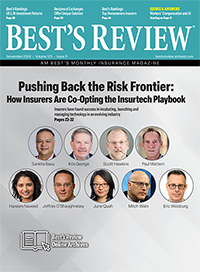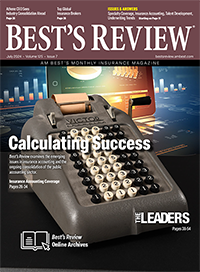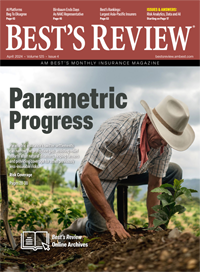Life Insurance
Stepping It Up
John Hancock’s Vitality program transforms the traditional static relationship of life insurance ownership into an interactive experience with their policyholders.
Brooks Tingle, president and chief executive officer, John Hancock Insurance, said the organization wants to promote engagement with insureds by partnering with a growing range of tech and service providers. Tingle spoke with AMBestTV at InsureTech Connect 2019, held in Las Vegas.
Following is an edited transcript of the interview.
Innovation in life insurance has occurred at a measured pace. How can you accelerate that?
It really starts with the recognition of the absolute imperative to innovate and change. It occurred to us four or five years ago that we were selling a product that no one really wanted to own. Most people buy life insurance out of some sense of obligation or commitment but no one got any joy whatsoever out of it.
Owning life insurance isn't a particularly pleasant experience. I joke I have some policies where my ownership experience is paying a bill and then dying. Not very engaging or meaningful.
We're selling a product that is very boring to own. No one really wanted to buy it. Combine that with the fact that it's incredibly hard to buy. I often joke that I don't think there's a product in the modern economy today more difficult to buy than life insurance.
We always say that buying a home is difficult but your realtor doesn't ask you for your blood and urine, at least I'd hope not.
Selling a product that no one really wants to own, no one really gets any joy out of owning, and is incredibly hard to buy is hardly a winning formula in the modern digital economy.
First, it starts with that absolute imperative that if we don't change and change radically our business is going to decline and lose its relevance to today's consumer. Then, there are a whole bunch of things once you realize that, but that's the catalyst, is understanding that and understanding the urgency of it.
Then, once you're on that journey, a whole bunch of other things we could talk about. How you need to move faster. Not always easy in companies that are often 100, 150 years old. We like to think that we've shown that you can do it.

People are thinking about their life insurance almost every day when they’re at the grocery store or they’re checking into a hotel that they got a discount on their hotel stay through our program.
Brooks Tingle
John Hancock
How do you change that formula? How do you make people want to buy life insurance?
We think you have to make it more meaningful to own, make it as much about living as dying. With our Vitality solution, some people may know that it's a program that rewards people for taking steps to live a longer, healthier life. You go for a walk, you get some points. You go see your doctor, you get some points. You buy healthy foods, you get points.
These points accumulate. You earn a status level. You get different discounts and different rewards.
Through that program, a couple things have happened. One, we've totally transformed that ownership experience of life insurance. Instead of buying a policy, tucking it on a shelf somewhere, and maybe thinking about it once a year when you pay a bill or maybe twice a year when you get a privacy notice, we're interacting with our Vitality customers about 40 times a month now. That's through the app. They're earning points. They're claiming rewards. They're consuming educational content. That's part of it, transforming that interaction model, the engagement model.
People are thinking about their life insurance almost every day when they're at the grocery store or they're checking into a hotel that they got a discount on their hotel stay through our program.
The second part, though, is picking really good partners. I'm very proud of our company. If we were to do or try to do all these things ourselves, we would fail miserably.
Picking partners like Vitality for the core program, but then we work with Apple. We have a wonderful Apple Watch part of our program. Amazon's on our platform now. People that maintain the highest status level in our program for three years get a free Amazon Prime membership.
You bring all these very relevant brands and companies that people are used to working with every day into the life insurance ownership experience, and suddenly it feels like something very different than something I think about once a year until I die.
How do you choose partners? What's a criteria you look for in a partner?
There are two types of partners we work with. First of all, our primary ambition is to help customers live longer, healthier lives. At the end of the day, we think it's eminently rational that a life insurer should want to help their customers live longer, right? Good for the customer, good for us.
We work with a lot of people in the scientific realm about what are things we can encourage our customers to do that will help them live a longer, healthier life. Other sets of partners are more around: Is this an appealing solution, an appealing brand, an appealing offer?
What American these days doesn't want an Amazon Prime membership for free? Something like the Apple Watch is quite interesting and compelling because it serves a great purpose as it relates to helping people live longer, healthier lives.
Rand did a study that shows that people that use the Apple Watch in our program are significantly more physically active than regular consumers. The new Apple Watches have wonderful features around heart monitoring and things like that. What company should want their customers carrying around a hospital-quality heart monitor on their wrist more than their life insurance company, right?
It has tremendous consumer appeal, as well. A lot of people want an Apple Watch. It's a mix of those types of features.
You bring up Apple, which has a cult-like following among its users. Same with Amazon. Is there a rub-off effect to that brand affinity?
If you had said to me five years ago we would be regularly working with companies like that in the life insurance business, I'd say you're crazy. How and why?
It works, though. That's true. We're proud to associate with companies like that. I think we do nice things for them, too. In the case of the Apple Watch, it's a wonderful use case for the Apple Watch. It truly is helping people live longer, healthier lives.
At the end of the day, it's not just about branding. At the end of the day it's really about, are we helping customers take steps to live a longer, healthier life? It certainly helps making it more relevant.
There are other brands, by the way, maybe not quite the household names, that play a very important part of our ecosystem.
A lot of our customers are clamoring for meditation solutions. Last year, we added Headspace [a meditation app] to the program. Our customers can now get a free subscription there. People can get points for meditating. We now have a sleep component to the program. It's an ever-expanding list of partners. Sometimes, maybe a little lesser known, but a really cool solution that actually helps customers live better.
It's wonderful when the solution combines both a big, wonderful brand name that everybody admires and really powerful technology.
What's the regulatory environment like when you're trying to do some of these innovative partnerships or innovate in general?
Regulators and regulation get blamed too much for a lack of innovation in our industry. I hear a lot of my peers say, “It's hard to change this because the regulators won't like it.”
The regulators play an important role in our business. It is inherently complicated. As a life insurer, we're dealing with 50 states and a number of territories. I can say I have found, through the process of getting Vitality to market and some other things we are doing, that typically the regulators are quite open to innovation.
You need to be proactive and engage them and explain what you're doing. More importantly, why you are doing it. We want to help customers live a longer, healthier life. No one could particularly be against that.
Now, how we do it is subject to regulation. We work closely with the regulators.
The regulatory environment is evolving, too. Many states have innovation sandboxes now. There's an innovation committee within the NAIC. I don't think we should point to regulation as a reason that we can't innovate.



































